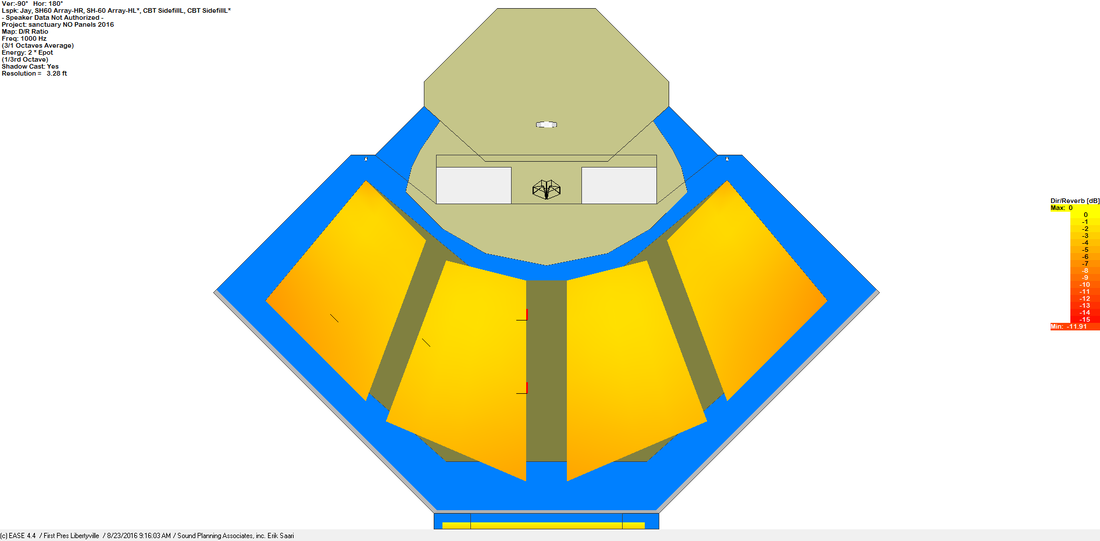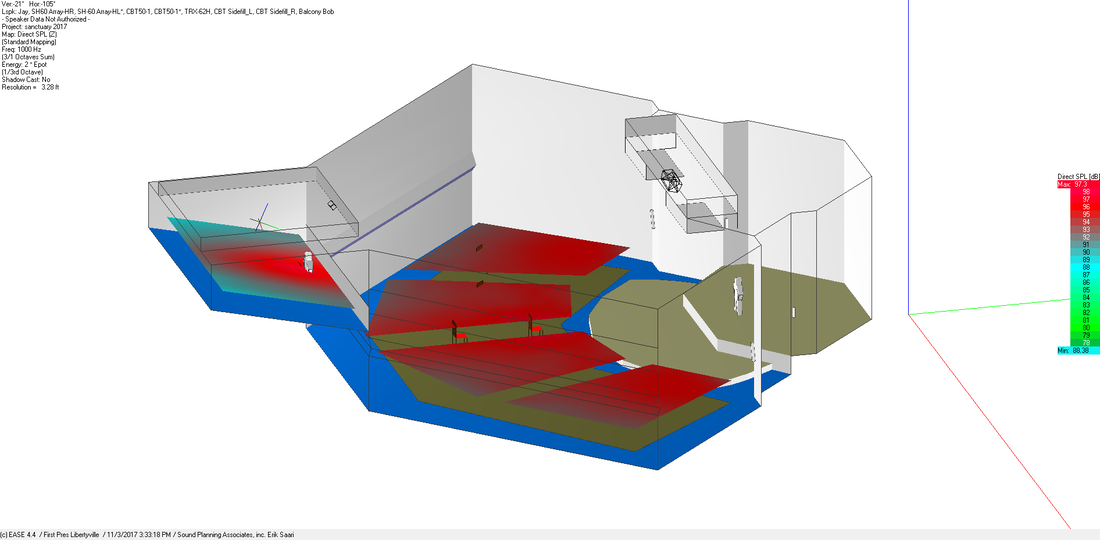Sound Planning uses EASE acoustic modeling software to evaluate loudspeakers and their affect on the room acoustics. This gives us the ability to test and verify system performance before we even order the equipment. We not only use these tools to help in systems design, but also in illustrating the benefits of the sound system to the lay person. We know that acoustics are a major part of the experience. Planning the right sound system includes complimenting the acoustics and aesthetics of the building.
This type of service normally is only available from acoustics consultants due to the amount of training and expertise it takes to use. Fortunately, Sound Planning is proficient in using EASE for all its projects. The benefit is a comprehensive design of a consultant-led project at a design-build price!
The Three Cs of Great Sound
1. Coverage
2. Clarity
3. Consistency
Coverage:
Everyone has experienced an environment where sound level varies greatly from spot to spot. It seems that unless you get the “good seats” you are stuck in a dead spot with low-levels of sound and you are fighting to hear the presenter, vocalist or musician. A properly designed sound system will provide coverage that evenly distributes the sound to all the of the audience areas. And all of the audience will hear the levels at the same defined range.
Clarity:
Clarity in terms of speech is intelligibility. Intelligibility is the difference between listening to the presenter and following along or thinking while the presenter is mid-sentence and wondering, “Did he say sixty or sixteen?”
Clarity in terms of performance acoustics is the difference in experiencing a wonderful and musical reverb or experiencing distracting early reflections.
Consistency:
A sound system is only a good one if you know how to get to the appropriate system setting consistently. A good system design will allow the operator to achieve this every time.
The following examples will help understand the first two Cs (Coverage and Clarity) using EASE acoustic modeling software.
To better explain what the following modeled pictures show, the color bar graph on the left of the chart below shows how an EASE model shows the level of decibels (dB).
The left graph measures 20 decibels of range on the chart (I.E. 74~94dB shown).
This type of service normally is only available from acoustics consultants due to the amount of training and expertise it takes to use. Fortunately, Sound Planning is proficient in using EASE for all its projects. The benefit is a comprehensive design of a consultant-led project at a design-build price!
The Three Cs of Great Sound
1. Coverage
2. Clarity
3. Consistency
Coverage:
Everyone has experienced an environment where sound level varies greatly from spot to spot. It seems that unless you get the “good seats” you are stuck in a dead spot with low-levels of sound and you are fighting to hear the presenter, vocalist or musician. A properly designed sound system will provide coverage that evenly distributes the sound to all the of the audience areas. And all of the audience will hear the levels at the same defined range.
Clarity:
Clarity in terms of speech is intelligibility. Intelligibility is the difference between listening to the presenter and following along or thinking while the presenter is mid-sentence and wondering, “Did he say sixty or sixteen?”
Clarity in terms of performance acoustics is the difference in experiencing a wonderful and musical reverb or experiencing distracting early reflections.
Consistency:
A sound system is only a good one if you know how to get to the appropriate system setting consistently. A good system design will allow the operator to achieve this every time.
The following examples will help understand the first two Cs (Coverage and Clarity) using EASE acoustic modeling software.
To better explain what the following modeled pictures show, the color bar graph on the left of the chart below shows how an EASE model shows the level of decibels (dB).
The left graph measures 20 decibels of range on the chart (I.E. 74~94dB shown).
For good COVERAGE the goal is a uniform level of sound at all seating areas. EASE shows this by having a color range on the seating area or “Audience Plane”. We will use measurements like: Direct SPL to show the amount of direct coverage to the audience from the loudspeaker.
For good CLARITY the goal of the speaker system design is to make sure the speakers provide a large difference in levels between the direct sound at the listener (good sound) to the reflected sound from the wall areas & ceilings surfaces (bad sound). We use measurements like: "D-R" Direct to Reverberant Ratio and "STI" Speech Transmission Index and others to study the amount of reflected coverage that is reaching the audience. These measurements are crucial in understanding how the room acoustics will behave when the loudspeakers are on.
For good CLARITY the goal of the speaker system design is to make sure the speakers provide a large difference in levels between the direct sound at the listener (good sound) to the reflected sound from the wall areas & ceilings surfaces (bad sound). We use measurements like: "D-R" Direct to Reverberant Ratio and "STI" Speech Transmission Index and others to study the amount of reflected coverage that is reaching the audience. These measurements are crucial in understanding how the room acoustics will behave when the loudspeakers are on.









